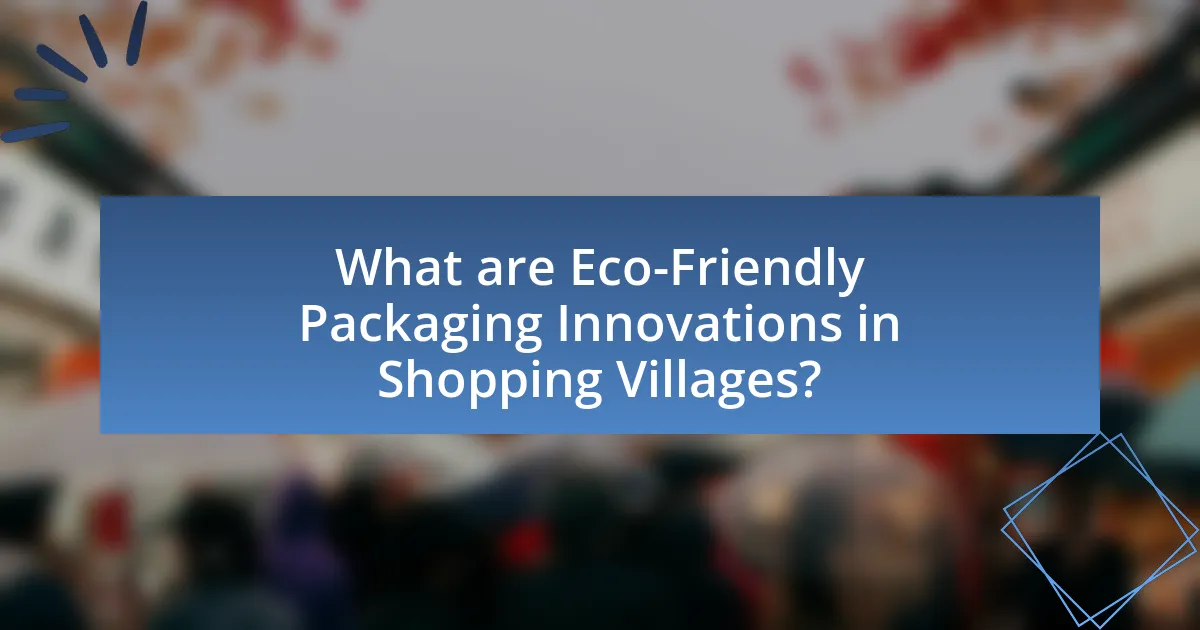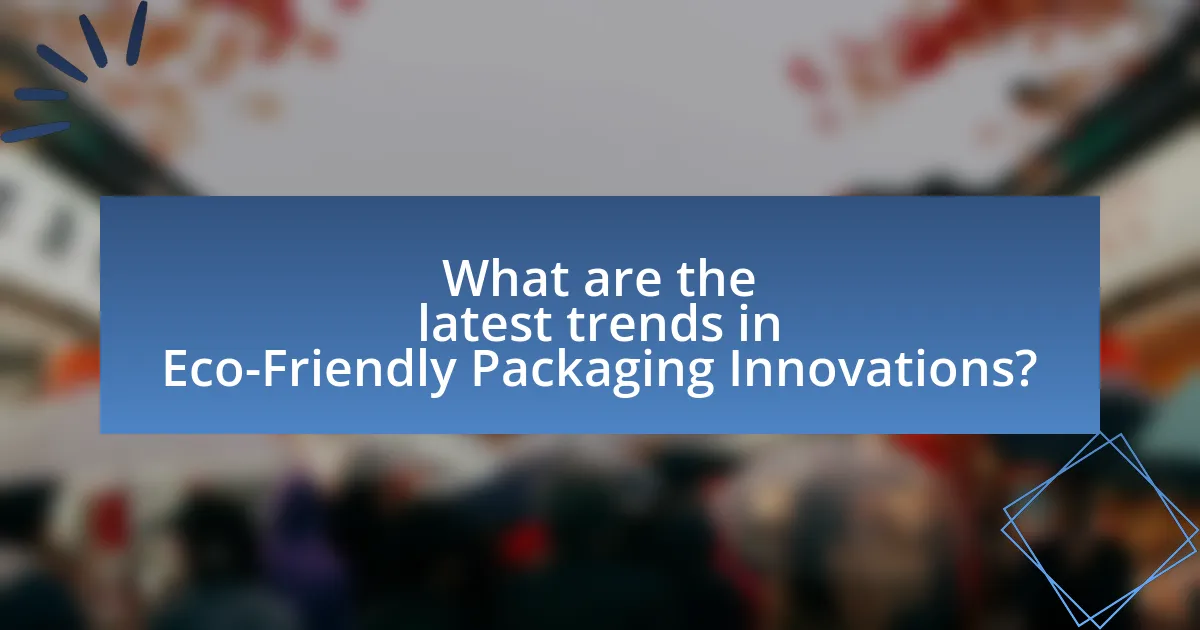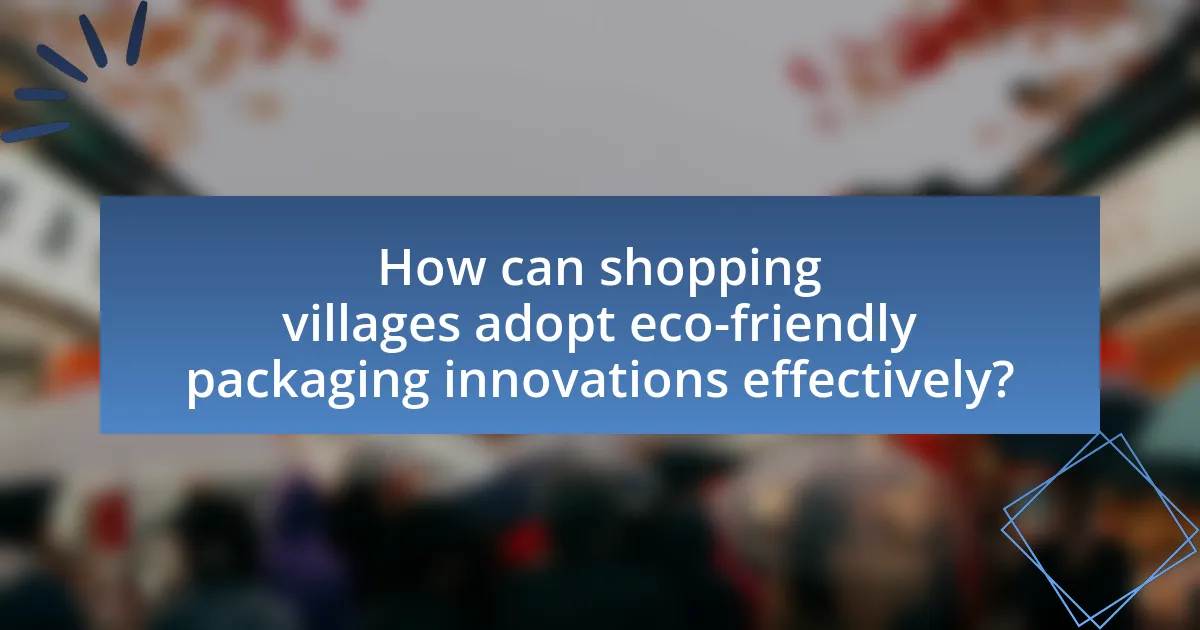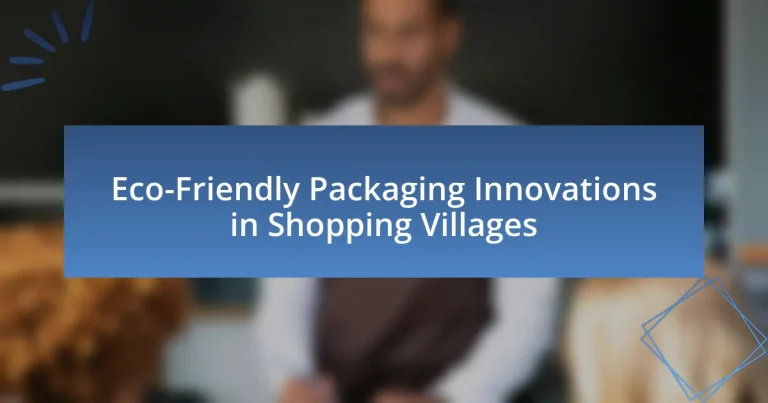Eco-friendly packaging innovations in shopping villages focus on sustainable materials and practices aimed at reducing environmental impact. Key innovations include biodegradable materials, reusable packaging systems, and plant-based alternatives to traditional plastics, which collectively minimize waste and appeal to environmentally conscious consumers. The article explores the benefits of these innovations, such as enhanced consumer satisfaction and loyalty, while also addressing challenges like cost and supply chain limitations. Additionally, it highlights successful case studies and practical tips for shopping villages to effectively implement eco-friendly packaging solutions, ultimately promoting a more sustainable shopping experience.

What are Eco-Friendly Packaging Innovations in Shopping Villages?
Eco-friendly packaging innovations in shopping villages include the use of biodegradable materials, reusable packaging systems, and plant-based alternatives to traditional plastics. Biodegradable materials, such as those made from cornstarch or mushroom mycelium, decompose naturally, reducing landfill waste. Reusable packaging systems encourage customers to return containers for refills, minimizing single-use waste. Additionally, plant-based alternatives, like packaging derived from seaweed or bamboo, offer sustainable options that reduce reliance on fossil fuels. These innovations are increasingly adopted as shopping villages aim to enhance sustainability and reduce their environmental impact.
How do these innovations impact the shopping experience?
Eco-friendly packaging innovations significantly enhance the shopping experience by promoting sustainability and reducing environmental impact. These innovations, such as biodegradable materials and reusable packaging, appeal to environmentally conscious consumers, leading to increased customer satisfaction and loyalty. Research indicates that 73% of consumers are willing to change their shopping habits to reduce environmental impact, demonstrating a strong preference for eco-friendly options. Additionally, shopping villages that implement these innovations often report higher foot traffic and sales, as they attract customers who prioritize sustainability in their purchasing decisions.
What types of eco-friendly materials are being used?
Eco-friendly materials being used include biodegradable plastics, recycled paper, and plant-based materials. Biodegradable plastics, such as polylactic acid (PLA), decompose naturally and reduce landfill waste. Recycled paper, sourced from post-consumer waste, minimizes deforestation and energy consumption. Plant-based materials, like bamboo and hemp, are renewable resources that offer sustainable alternatives to traditional packaging. These materials contribute to reducing environmental impact and promoting sustainability in shopping villages.
How do these materials compare to traditional packaging?
Eco-friendly packaging materials generally offer superior sustainability compared to traditional packaging. Traditional packaging often relies on plastics and non-biodegradable materials, contributing significantly to environmental pollution. In contrast, eco-friendly materials, such as biodegradable plastics, recycled paper, and plant-based substances, reduce waste and lower carbon footprints. For instance, a study published in the Journal of Cleaner Production found that biodegradable packaging can reduce greenhouse gas emissions by up to 70% compared to conventional plastic packaging. This demonstrates that eco-friendly materials not only mitigate environmental impact but also align with growing consumer demand for sustainable practices in shopping villages.
Why are eco-friendly packaging innovations important for shopping villages?
Eco-friendly packaging innovations are important for shopping villages because they reduce environmental impact and enhance consumer appeal. These innovations help minimize waste and pollution, aligning with the growing consumer demand for sustainable practices. For instance, a study by McKinsey & Company found that 66% of consumers are willing to pay more for sustainable brands, indicating that eco-friendly packaging can drive sales and customer loyalty in shopping villages. Additionally, implementing such packaging solutions can improve the overall image of shopping villages as environmentally responsible destinations, attracting more visitors and businesses focused on sustainability.
What environmental benefits do they provide?
Eco-friendly packaging innovations in shopping villages provide significant environmental benefits, including reduced waste and lower carbon emissions. These packaging solutions often utilize biodegradable or recyclable materials, which minimize landfill contributions and promote a circular economy. For instance, studies indicate that biodegradable packaging can decompose within months, unlike traditional plastics that can take hundreds of years. Additionally, eco-friendly packaging often requires less energy to produce, leading to a decrease in greenhouse gas emissions during manufacturing processes. This shift not only conserves natural resources but also encourages sustainable consumer behavior, fostering a more environmentally conscious shopping culture.
How do they influence consumer behavior?
Eco-friendly packaging innovations influence consumer behavior by increasing the likelihood of purchase among environmentally conscious consumers. Research indicates that 72% of consumers are willing to pay more for products with sustainable packaging, demonstrating a direct correlation between eco-friendly packaging and purchasing decisions. Additionally, brands that adopt sustainable practices often enhance their image, leading to increased customer loyalty and positive word-of-mouth, further driving consumer engagement and sales.
What challenges do shopping villages face in implementing these innovations?
Shopping villages face several challenges in implementing eco-friendly packaging innovations, primarily due to cost, consumer behavior, and supply chain limitations. The financial burden of transitioning to sustainable materials often deters shopping villages, as eco-friendly options can be more expensive than traditional packaging. Additionally, consumer resistance to changing habits and preferences for familiar packaging can hinder adoption. Furthermore, the existing supply chain may not support the sourcing and distribution of sustainable materials, complicating the implementation process. These factors collectively create significant barriers to the successful integration of eco-friendly packaging in shopping villages.
What are the cost implications of switching to eco-friendly packaging?
Switching to eco-friendly packaging typically results in higher initial costs due to the premium prices of sustainable materials compared to conventional options. For instance, studies indicate that biodegradable packaging can cost 10-30% more than traditional plastic. However, these costs can be offset over time through benefits such as reduced waste disposal fees, potential tax incentives, and increased consumer demand for sustainable products, which can enhance brand loyalty and sales. Additionally, companies that adopt eco-friendly practices may experience lower regulatory compliance costs in the long run as environmental regulations become stricter.
How can shopping villages overcome resistance from vendors?
Shopping villages can overcome resistance from vendors by demonstrating the economic and environmental benefits of eco-friendly packaging innovations. By providing data that shows how sustainable packaging can reduce costs in waste management and attract environmentally conscious consumers, shopping villages can persuade vendors to adopt these practices. For instance, a study by the Ellen MacArthur Foundation indicates that transitioning to circular packaging systems can lead to significant cost savings and increased customer loyalty. Additionally, offering incentives such as subsidies or marketing support for vendors who implement eco-friendly packaging can further encourage adoption.

What are the latest trends in Eco-Friendly Packaging Innovations?
The latest trends in eco-friendly packaging innovations include the use of biodegradable materials, plant-based plastics, and reusable packaging systems. Biodegradable materials, such as those derived from cornstarch or mushroom mycelium, break down naturally and reduce landfill waste. Plant-based plastics, made from renewable resources like sugarcane, offer a sustainable alternative to traditional petroleum-based plastics, significantly lowering carbon footprints. Additionally, reusable packaging systems, which encourage consumers to return containers for refills, are gaining traction as they minimize single-use waste and promote a circular economy. These trends reflect a growing commitment to sustainability in the packaging industry, driven by consumer demand for environmentally responsible products.
How are technology and design evolving in this space?
Technology and design in eco-friendly packaging innovations for shopping villages are evolving through the integration of sustainable materials and smart packaging solutions. Advances in biodegradable materials, such as plant-based plastics and recycled paper, are being adopted to reduce environmental impact. Additionally, the use of digital technology, like QR codes and augmented reality, enhances consumer engagement and provides information on recycling and sustainability practices. Research indicates that the global biodegradable plastics market is projected to reach $6.9 billion by 2025, reflecting a significant shift towards eco-conscious packaging solutions.
What role does biodegradable packaging play in shopping villages?
Biodegradable packaging plays a crucial role in shopping villages by reducing environmental impact and promoting sustainability. This type of packaging decomposes naturally, minimizing waste in landfills and decreasing pollution associated with traditional plastic packaging. According to a study published in the Journal of Cleaner Production, biodegradable materials can reduce carbon emissions by up to 50% compared to conventional plastics. By adopting biodegradable packaging, shopping villages enhance their eco-friendly image, attract environmentally conscious consumers, and contribute to a circular economy, thereby fostering a more sustainable retail environment.
How is smart packaging technology being integrated?
Smart packaging technology is being integrated through the incorporation of sensors, QR codes, and RFID tags that enhance product tracking and consumer interaction. These technologies allow for real-time monitoring of product conditions, such as temperature and humidity, ensuring quality and safety during transportation and storage. For instance, a study by the Packaging Technology and Science journal highlights that the use of RFID tags can reduce supply chain errors by up to 30%, demonstrating the effectiveness of smart packaging in improving logistics and consumer engagement.
What are some successful case studies of eco-friendly packaging in shopping villages?
Successful case studies of eco-friendly packaging in shopping villages include the implementation of biodegradable packaging by the Village Green shopping center in the UK, which reduced plastic waste by 30% within the first year. Another example is the use of reusable cloth bags by the Eco Village in Australia, leading to a 50% decrease in single-use plastic bags among shoppers. Additionally, the Green Market in the Netherlands adopted compostable packaging for food vendors, resulting in a 40% increase in customer satisfaction regarding sustainability. These initiatives demonstrate effective strategies for reducing environmental impact while enhancing consumer engagement.
Which shopping villages have effectively implemented these innovations?
The shopping villages that have effectively implemented eco-friendly packaging innovations include Bicester Village in the UK and La Vallée Village in France. Bicester Village has introduced biodegradable packaging options and encourages retailers to adopt sustainable practices, while La Vallée Village has partnered with brands to promote the use of recycled materials in their packaging. These initiatives demonstrate a commitment to sustainability and have been recognized in industry reports for their impact on reducing environmental waste.
What lessons can be learned from these case studies?
The lessons learned from the case studies on eco-friendly packaging innovations in shopping villages include the importance of sustainability, consumer engagement, and collaboration among stakeholders. These case studies demonstrate that adopting sustainable packaging solutions not only reduces environmental impact but also enhances brand loyalty, as consumers increasingly prefer eco-conscious products. For instance, a study by the Ellen MacArthur Foundation highlights that businesses implementing circular economy principles in packaging can significantly reduce waste and improve resource efficiency. Additionally, successful case studies show that collaboration between retailers, manufacturers, and local governments can lead to innovative solutions that benefit the entire community, reinforcing the idea that collective action is essential for meaningful change in packaging practices.

How can shopping villages adopt eco-friendly packaging innovations effectively?
Shopping villages can adopt eco-friendly packaging innovations effectively by collaborating with sustainable packaging suppliers and implementing a circular economy model. This approach allows shopping villages to source biodegradable, recyclable, or reusable packaging materials that minimize environmental impact. For instance, using materials like plant-based plastics or recycled paper can significantly reduce waste. Additionally, educating retailers and consumers about the benefits of eco-friendly packaging fosters a culture of sustainability. Research indicates that 66% of consumers are willing to pay more for sustainable brands, highlighting the market demand for eco-friendly options. By integrating these practices, shopping villages can enhance their environmental responsibility while meeting consumer expectations.
What steps should be taken to transition to eco-friendly packaging?
To transition to eco-friendly packaging, businesses should first assess their current packaging materials and identify alternatives that are biodegradable, recyclable, or made from renewable resources. This assessment allows companies to understand the environmental impact of their existing packaging and explore options such as plant-based plastics, recycled paper, or reusable containers.
Next, businesses should engage suppliers who specialize in sustainable packaging solutions, ensuring that the materials sourced align with eco-friendly standards. Collaborating with suppliers can lead to innovative packaging designs that reduce waste and enhance product protection.
Additionally, companies should implement a phased approach to gradually replace non-eco-friendly packaging with sustainable options, allowing time for consumer adaptation and feedback. This strategy can be supported by educating customers about the benefits of eco-friendly packaging, which can increase acceptance and demand.
Finally, businesses should monitor and evaluate the effectiveness of their new packaging solutions, making adjustments based on performance and customer feedback. This continuous improvement process ensures that the transition to eco-friendly packaging is effective and aligns with sustainability goals.
How can shopping villages educate their vendors about these innovations?
Shopping villages can educate their vendors about eco-friendly packaging innovations through structured training programs and workshops. These initiatives can include expert-led sessions that cover the latest sustainable materials, benefits of eco-friendly packaging, and practical implementation strategies. For instance, research from the Ellen MacArthur Foundation highlights that businesses adopting sustainable practices can reduce costs and improve brand loyalty, demonstrating the tangible benefits of such education. Additionally, providing access to online resources and case studies of successful implementations can further enhance vendors’ understanding and encourage adoption of these innovations.
What partnerships can be formed to enhance eco-friendly practices?
Partnerships between shopping villages and local eco-friendly packaging suppliers can significantly enhance eco-friendly practices. By collaborating with suppliers that specialize in biodegradable or recyclable materials, shopping villages can reduce their environmental footprint. Additionally, partnerships with environmental organizations can provide educational resources and promote sustainable practices among vendors and consumers. Research indicates that businesses engaging in sustainability partnerships can improve their brand image and customer loyalty, as seen in the 2021 study by the World Economic Forum, which highlighted that 66% of consumers are willing to pay more for sustainable brands.
What best practices should shopping villages follow for sustainable packaging?
Shopping villages should prioritize the use of biodegradable, recyclable, and reusable packaging materials to promote sustainability. Implementing these practices reduces environmental impact by minimizing waste and encouraging responsible consumption. For instance, using materials like compostable bioplastics or recycled paper can significantly lower carbon footprints. Additionally, shopping villages can collaborate with suppliers to ensure that packaging aligns with sustainability goals, as evidenced by a study from the Ellen MacArthur Foundation, which highlights that transitioning to circular packaging systems can reduce plastic waste by up to 80%. By adopting these best practices, shopping villages can effectively contribute to a more sustainable future.
How can they measure the impact of their eco-friendly initiatives?
They can measure the impact of their eco-friendly initiatives by analyzing key performance indicators (KPIs) such as waste reduction, carbon footprint, and customer feedback. For instance, tracking the amount of packaging waste diverted from landfills can provide quantifiable data on the effectiveness of eco-friendly packaging solutions. Additionally, conducting surveys to gauge customer satisfaction and awareness regarding these initiatives can offer insights into their perceived value. Research indicates that businesses implementing sustainable practices can see a 20% increase in customer loyalty, reinforcing the importance of measuring both environmental and consumer impact.
What resources are available for ongoing support and improvement?
Resources available for ongoing support and improvement in eco-friendly packaging innovations in shopping villages include industry associations, government grants, and educational programs. Industry associations, such as the Sustainable Packaging Coalition, provide networking opportunities, best practices, and resources for businesses to adopt sustainable packaging solutions. Government grants, like those from the Environmental Protection Agency, offer financial assistance for projects aimed at reducing environmental impact through innovative packaging. Educational programs, including workshops and online courses from institutions like the Ellen MacArthur Foundation, equip stakeholders with knowledge on sustainable practices and emerging technologies in packaging. These resources collectively enhance the capacity for continuous improvement in eco-friendly packaging initiatives.
What practical tips can shopping villages implement for eco-friendly packaging?
Shopping villages can implement several practical tips for eco-friendly packaging, such as using biodegradable materials, encouraging reusable bags, and minimizing packaging size. Biodegradable materials, like plant-based plastics, decompose naturally and reduce landfill waste. Encouraging customers to bring reusable bags can significantly decrease single-use plastic consumption; studies show that reusable bags can replace thousands of plastic bags over their lifespan. Additionally, minimizing packaging size not only reduces material use but also lowers transportation emissions, as smaller packages are more efficient to ship. These strategies collectively contribute to a more sustainable shopping environment.


